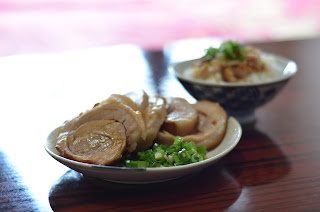 |
| Japanese Chasu |
Japanese Chasu is quite different from the Chinese Chasiu. Japanese Chasu is mainly roast pork in soy sauce while Chinese Chasiu is a barbecue pork with soy sauce and hoisin sauce. Japanese Chasu often uses the pork belly meat while Chinese Chasu mainly used the pork loin meat.
I love the round Japanese Chasu that you often find in a bowl of delicious ramen. After all, what's not to love about this juicy dish - with layers of fats and tender meat melting in your mouth at every bite. Yummy-licious is the word for it.
 |
| Japanese Chasu rice |
One of our favorite Chasu from Santouka. We never failed to order an extra bowl of Chasu rice when we visit Santouka. The Santouka's Chasu uses mainly pork cheeks meat which is one of the fattiest meat of the pig but the most tender. You can get pork cheeks meat at many Chinese supermarket. It is sometimes also called pork neck meat. However, it's difficult to achieve the round Chasu shape with pork neck meat, so I chose to use pork belly meat for my Chasu recipe.
After searching through various blogs, I combined and tweaked the recipes from Just One Cookbook and No Recipe to come up with my easy to make Chasu recipe.
 |
| Japanese Chasu with rice |
Japanese Chasu
Recipe
2 piece of pork belly meat (2 pounds each - request your butcher to remove the skin)
2 tablespoon of Konbu Cha or salt
3 cup water
4 tablespoon sugar
4 tablespoon miso
6 tablespoon soy sauce
8 tablespoon mirin
8 tablespoon sake
30 grams ginger (slice into 4 ~ 5 pieces)
8 cloves garlic (smashed)
1/2 tablespoon of white pepper corns
1 stalk of green onion (cut into 4 inches)
1. Rub the pork belly with Konbu Cha or salt.
2. Roll the pork belly into a round shape. Using the pork belly skin, wrap around the meat and secure with string. If you don't need the round shape, cut the pork belly into 4 quarters.
3. Put all ingredients into a pot. The sauce or water should cover 3/4 of the pork.
4. Cover the pork with an Otoshibuta. Make sure that all corners of the pot is covered and steam is only coming out of the holes of the Otoshibuta.
5. Cooking over medium high heat for approximately 10 minutes. Once it starts to simmer, lower the heat to medium low and cook the meat for approximately 2.5 hours.
6. Check the meat occasionally after 2 hours. Turn off heat when there is only 1 inch of the liquid left. The liquid should have thicken and is shiny.
7. Wait for meat to cool completely before slicing.
******************************************************************************************************
Tips and tricks
1. Using the Otoshibuta is very important. It allows for the heat is evenly distributed.2. When using the Otoshibuta, make sure that all "corners" are covered. Steam should only escape from the holes that is on the Otoshibuta and not from the side. This allows for longer cooking time and prevent the water are drying up. Longer cook time is required for the meat to be completely tender.
3. The Otoshibuta should be placed on top of the meat. Not used as a cover for the pot. Do not cover the pot. Do not use pot cover.
4. Check on meat occasionally after 2 hours. (At least every 10 ~ 15 minutes) You can stir or move the meat slightly to prevent burning.
5. Cooking time will need to be adjusted if you make smaller portion. Check after 1 hour of cooking instead of 2 hours.
******************************************************************************************************
My Japanese Pantry
Here are some of the seasoning that I used for this recipe. |
| Mirin |
Mirin (can be found in Japanese and Asian supermarket at the sauce section - together with soy sauce)
 |
| Miso |
Miso (Mainly found in Japanese supermarket and some Asian supermarket at ready-made soup section)
 |
| Sake |
Sake (Any sake should work. For cooking purposes, I just use the cheapest available.)
 |
| Konbu Cha |
Konbu Cha (Found in Japanese supermarket, in the tea section. Just ask for Kelp tea.)
Disclaimer - I am not compensated monetary in any way for the shopping links. I just google online and place them here for easy reference.
No comments:
Post a Comment